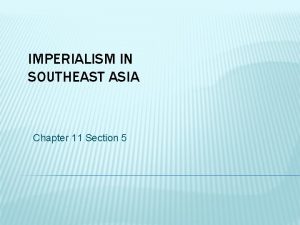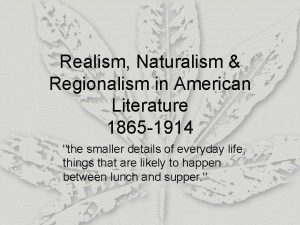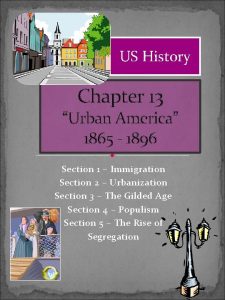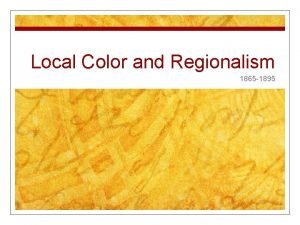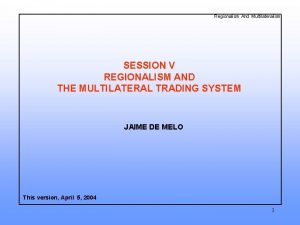Regionalism 1865 1895 Regionalism Definition According to the







- Slides: 7

Regionalism 1865 -1895

Regionalism - Definition According to the Oxford Companion to American Literature, "In localcolor literature one finds the dual influence of romanticism and realism, since the author frequently looks away from ordinary life to distant lands, strange customs, or exotic scenes, but retains through minute detail a sense of fidelity and accuracy of description" (439).

Techniques Focuses on the characters, dialect, customs, topography, and other features particular to a specific region to establish credibility and authenticity of regional characters. Use of detailed description, especially of small, seemingly insignificant details central to an understanding of the region. Frequent use of a frame story in which the narrator hears some tale of the region.

Characteristics Setting: The emphasis is frequently on nature and the limitations it imposes; settings are frequently remote and inaccessible. The setting is integral to the story and may sometimes become a character in itself. Characters: Local color stories tend to be concerned with the character of the district or region rather than with the individual: characters may become character types, sometimes quaint or stereotypical. The characters are marked by their adherence to the old ways, by dialect, and by particular personality traits central to the region. In women's local color fiction, the heroines are often unmarried women or young girls. Narrator: The narrator is typically an educated observer from the world beyond who learns something from the characters while preserving a sometimes sympathetic, sometimes ironic distance from them. The narrator serves as mediator between the rural folk of the tale and the urban audience to whom the tale is directed.

Characteristics Plots. It has been said that "nothing happens" in local color stories by women authors, and often very little does happen. Stories may include lots of storytelling and revolve around the community and its rituals. Themes: Many local color stories share an antipathy to change and a certain degree of nostalgia for an always-past golden age. A celebration of community and acceptance in the face of adversity characterizes women's local color fiction. Thematic tension or conflict between urban ways and old-fashioned rural values is often symbolized by the intrusion of an outsider or interloper who seeks something from the community.

Regionalism or Realism or Local Color Regional literature incorporates the broader concept of sectional differences, although in Writing Out of Place, Judith Fetterley and Marjorie Pryse have argued convincingly that the distinguishing characteristic that separates "local color" writers from "regional" writers is instead the exploitation of and condescension toward their subjects that the local color writers demonstrate. One definition of the difference between realism and local color is Eric Sundquist's: "Economic or political power can itself be seen to be definitive of a realist aesthetic, in that those in power (say, white urban males) have been more often judged 'realists, ' while those removed from the seats of power (say, Midwesterners, blacks, immigrants, or women) have been categorized as regionalists.

Regionalism Unites the Country Many critics, including Amy Kaplan ("Nation, Region, and Empire" in the Columbia Literary History of the United States) and Richard Brodhead (Cultures of Letters), have argued that this literary movement contributed to the reunification of the country after the Civil War and to the building of national identity toward the end of the nineteenth century. According to Brodhead, "regionalism's representation of vernacular cultures as enclaves of tradition insulated from larger cultural contact is palpably a fiction. . . its public function was not just to mourn lost cultures but to purvey a certain story of contemporary cultures and of the relations among them" (121). In chronicling the nation's stories about its regions and mythical origins, local color fiction through its presence--and, later, its absence--contributed to the narrative of unified nationhood that late nineteenth-century America sought to construct.
